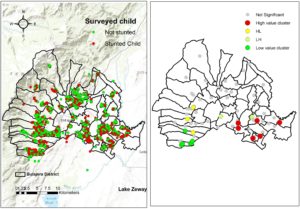Kabalo, Bereket Yohannes, Seifu Hagos Gebreyesus, Eskindir Loha, and Bernt Lindtjørn. “Performance of an Adapted Household Food Insecurity Access Scale in Measuring Seasonality in Household Food Insecurity in Rural Ethiopia: A Cohort Analysis.” BMC Nutrition 5, no. 1 (2019/11/20 2019): 54. https://doi.org/10.1186/s40795-019-0323-6
Background Seasonality poses a considerable food security challenge in Ethiopia. Yet, measuring seasonal variations in food insecurity, particularly the dimension of food access, lacks an adequately validated tool. We therefore evaluated the performance of an adapted Household Food Insecurity Access Scale (HFIAS) to estimate seasonal variations in food insecurity (FI) among subsistence villagers in Ethiopia.
Methods We employed a cohort study design using a panel of four repeated measurements taken in June, September, and December in the year 2017, and in March 2018. The study recruited 473 villagers from the drought-affected Wolaita area in southwest Ethiopia. The performance of the HFIAS was evaluated via internal consistency (Chronbach’s alpha values) and criterion validation techniques. The set of criteria include: parallelism between affirmative responses to FI questions and wealth strata; dose-response relationship between FI and dietary intake; and also FI severity and household wealth status.
Results This study revealed that the HFIAS had satisfactory performance in four repeated measurements. The likelihood of affirmative responses to questions about FI decreased with ascending wealth quintiles. We observed an inverse dose-response relationship between FI and wealth status, and between FI and household dietary diversity.
Conclusions The HFIAS showed an acceptable potential for measuring seasonal variations in FI in the study area. Our findings complement efforts to evaluate the scale’s applicability in various settings, in order to promote cross-culture monitoring and comparisons. However, it required a careful adaption for contextual and cultural sensitivities.

 On Friday June 22, 2018 Taye Gari Anaya will defend his PhD thesis at the University of Bergen.
On Friday June 22, 2018 Taye Gari Anaya will defend his PhD thesis at the University of Bergen. Hagos S, Hailemariam D, WoldeHanna T, Lindtjørn B (2017) Spatial heterogeneity and risk factors for stunting among children under age five in Ethiopia: A Bayesian geo-statistical model.
Hagos S, Hailemariam D, WoldeHanna T, Lindtjørn B (2017) Spatial heterogeneity and risk factors for stunting among children under age five in Ethiopia: A Bayesian geo-statistical model.